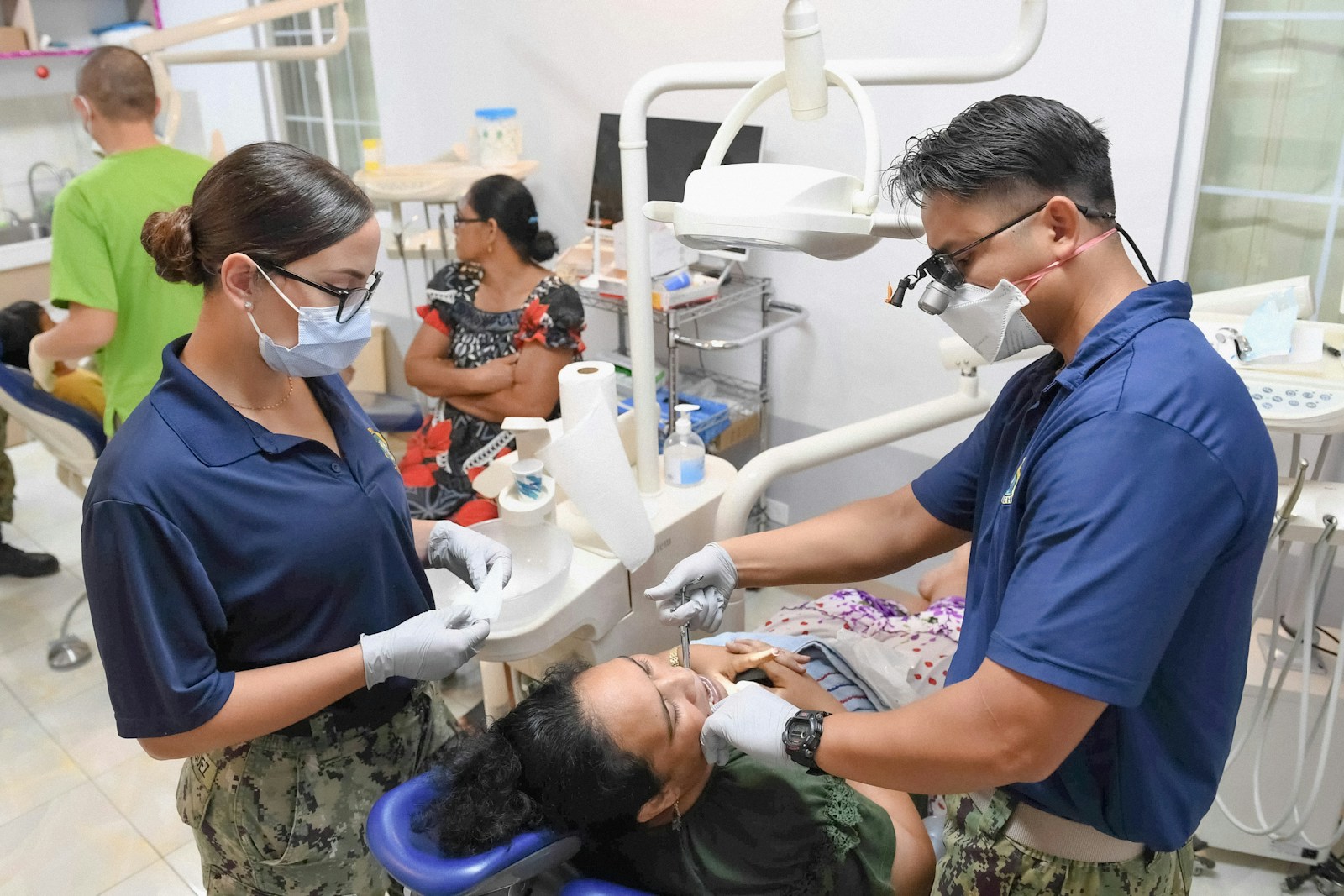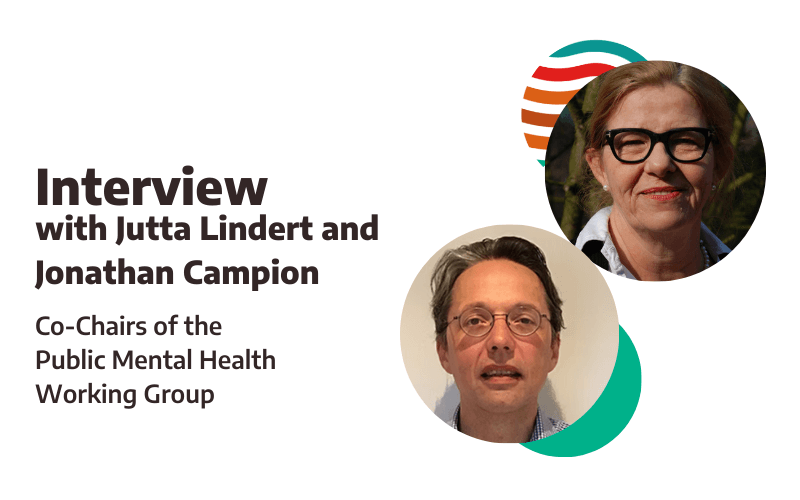Public mental health is an increasingly recognized component of public health, vital for improving population well-being and addressing inequalities worldwide. In this interview, we speak with Professor Jutta Lindert and Dr. Jonathan Campion, co-chairs of the World Federation of Public Health Associations’ (WFPHA) Public Mental Health Working Group.
Jutta and Jonathan share their insights, experiences, and visions for advancing public mental health.
Jonathan and Jutta – please introduce yourselves.
Jonathan Campion: I’m Director of Public Mental Health and Consultant Psychiatrist at South London and Maudsley NHS Foundation Trust in the UK. I am also co-chair of the Public Mental Health Section at the European Psychiatric Association and chair of the Public Mental Health Special Interest Group at the World Psychiatric Association. At the WFPHA, I co-chair the Public Mental Health Working Group with Professor Jutta Lindert. Additionally, I’m an Honorary Professor of Public Mental Health at the University of Cape Town, South Africa.
Jutta Lindert: I am a Professor of Public Health from Germany, specializing in public mental health. I co-chair the Public Mental Health section of the European Public Health Association (EUPHA), which I founded 20 years ago. Back then, public mental health was rarely discussed, but it is now gaining prominence, not just in Europe but globally. I’m thrilled to see the WFPHA embracing this focus because mental health has historically been on the margins of public health. Today, it’s becoming a central concern.
At the WFPHA, I co-chair the Public Mental Health Working Group with Dr. Jonathan Campion. Additionally, I lead a huge European consortium on Youth Mental Health.
How long have you been part of the World Federation of Public Health Associations (WFPHA)?
Jonathan Campion: The WFPHA Public Mental Health Working Group was launched on 2/5/23 during the 17th World Congress on Public Health in Rome. I co-chair this group with Professor Lindert, and other members include Professor Bettina Borisch, Dr. Marta Caminiti, and Professor Paul Unschuld.
Jutta Lindert: I first observed the WFPHA’s work around 2002 or 2003 but couldn’t actively participate due to other commitments. Over the years, I have appreciated the Federation’s global perspective, essential for understanding and addressing mental health issues in diverse contexts. Now, I am honored to serve as co-chair for the newly founded Public Mental Health Working Group.
What interested you in entering the public health sector?
Jutta Lindert: My primary motivation has always been to improve the health of populations, particularly those living in vulnerable situations. As a researcher, I focus on identifying and mitigating health risks for these groups. It is very important for me to provide reliable data that can inform policies and actions. We need good science to respond to public health needs. Public health combines research and action—using evidence to reduce risks and improve outcomes for those most in need.
Jonathan Campion: I initially trained as a general practitioner and saw firsthand how pervasive mental health issues were, particularly in underserved settings. I also realized how neglected mental health was and how it both drives and is driven by social determinants. This inspired me to train in psychiatry and then focus on broader public mental health policy and practice. The massive implementation gap struck me for the treatment and prevention of mental health conditions and the promotion of mental well-being and resilience. I’m passionate about supporting the scale implementation of evidence-based public mental health interventions to sustainably reduce the burden of mental health conditions and promote well-being, particularly in marginalized communities.
What does public mental health mean to you?
Jonathan Campion: Public mental health involves a population approach to sustainably reduce the burden of mental health conditions and promote population mental wellbeing and resilience through scale implementation of evidence-based public mental health interventions to prevent associated impacts, treat mental health conditions, prevent mental health conditions, and promote mental well-being and resilience.
Despite the availability of such interventions provided by different sectors, there is a massive implementation gap, particularly in low- and middle-income countries —only a minority of those with mental health conditions receive treatment with negligible coverage of interventions to prevent mental health conditions or promote mental well-being and resilience. Addressing this gap prevents population-scale suffering, improves a range of public health relevant outcomes, and reduces associated economic costs. Public mental health approaches represent a key opportunity for public health.
Jutta Lindert: As WHO rightly emphasizes, there is no health without mental health. Public mental health is about more than just addressing mental disorders, which affect one-third of the global population during their lifetime. Mental health and mental health conditions need to be understood as a continuum. As symptoms can be identified at an early level, it is crucial to better understand the onset and trajectories of mental health conditions. It also involves fostering resilience and reducing environmental and social risks. Strengthening mental health prepares populations for change and transformation, reducing stigma and promoting openness.
What are your goals and visions for the WFPHA Public Mental Health Working Group?
Jutta Lindert: Our primary goal is to disseminate knowledge and foster collaboration across sectors, disciplines, and countries. We aim to deepen understanding through research and share findings via webinars, summer schools, and other platforms. Ultimately, we want to improve mental health literacy and public mental health outcomes worldwide.
My vision is to work on a global model of mental health —and leave more Euro or North American models behind to serve the world’s populations better.
Jonathan Campion: Our Working Group identified the following five key areas:
- Support public mental health knowledge, training, and practice.
- Integrate public mental health into public health work.
- Raise population awareness about mental health and resilience.
- Promote collaboration across systems and disciplines.
- Support the implementation and research of evidence-based public mental health interventions.
Our actions include fostering cross-sector collaboration, disseminating resources, organizing workshops, and publishing relevant research. For example, on World Mental Health Day 2023, the WFPHA partnered with the World Psychiatric Association and the World Organization of Family Doctors and signed a public mental health statement to advocate for a whole-system approach to address the global public mental health implementation gap. See more here.
Where do you see public mental health in the next five years?
Jutta Lindert: I hope that public health professionals will universally recognize the importance of public mental health in five years. I envision a world where mental health discussions are as normalized as those about physical health, helping to reduce stigma and foster inclusive conversations. Additionally, research on factors contributing to mental health is essential to Public Mental Health. By reducing risk factors, it might be possible to improve mental health.
Jonathan Campion: The next five years present a significant opportunity to address public mental health implementation failure, especially in low- and middle-income countries. We aim to support greater coordination between sectors and evidence-based action to address the public mental health implementation gap across different sectors. By 2030, we hope to have supported measurable progress in closing the public mental health implementation gap and advancing universal health coverage, including for mental health.
What can individuals do to support mental health—for themselves and others?
Jutta Lindert: Supporting others often enhances one’s mental health. Building caring societies and caring relationships is fundamental. We need to be the change we want to see; ethics is crucial to mental health. Alongside well-known strategies like physical activity and sufficient sleep, we need innovative approaches to bridge the gap between mental health needs and available care.
Last comments
Jutta Lindert: It’s crucial to spread mental health awareness across sectors and develop targeted strategies for different age groups. Building resilience and reducing risks can profoundly impact population health. Future research on public mental health should be supported to allow for more evidence-based actions.
How to support others and their own mental health
Jonathan Campion: Mental health affects every family. Promoting literacy about mental health, recognizing early signs of mental health conditions, and understanding preventive strategies are vital. For example, physical activity can effectively address early depression, while smoking cessation has a similar effect on depression as antidepressants. There are also things we can all do to promote our mental well-being.
Last comments
Jonathan Campion: Mental health intersects with other public health issues, like tobacco use, which disproportionately affects individuals with mental health conditions. Addressing these overlaps can significantly improve population health. Public health practitioners have a particularly important role in understanding what actions are required at different levels to address the implementation failure. This includes informing policymakers about the size of unmet needs and what the most implementable opportunities are to scale up particular interventions that would have maximum population mental health impact as well as a broad range of impacts across other sectors. The WFPHA’s leadership in public mental health is inspiring, and I look forward to working with the WFPHA on this important agenda.
Conclusion
Public mental health is integral to overall health and well-being. As Professors Lindert and Campion highlight, addressing the public mental health implementation gap and fostering collaboration across sectors can sustainably reduce the impact of mental health conditions and promote the population’s mental well-being and resilience. This results in a broad range of relevant public health impacts. The WFPHA Public Mental Health Working Group is poised to play a pivotal role in this global effort.
Working Group Members:
Professor Bettina Borisch: Professor of Public Health at the University of Geneva; CEO of World Federation of Public Health Associations.
Dr Marta Caminiti: Medical Resident in Public Health at University of Perugia, Italy; Co-chair the Public Mental Health Working Group at the World Federation of Public Health Associations.
Dr Jonathan Campion: Director for Public Mental Health and Consultant Psychiatrist at South London and Maudsley NHS Foundation Trust; Co-chair of the Public Mental Health Section at the European Psychiatric Association; Chair of the Public Mental Health Special Interest Group at the World Psychiatric Association; Co-chair the Public Mental Health Working Group at the World Federation of Public Health Associations: Honorary Professor of Public Mental Health at the University of Cape Town, South Africa.
Professor Jutta Lindert: Professor of Public Health at University of Emden (Germany); Co-chair of Public Mental Health Section at the European Public Health Association (EUPHA); Co-chair the Public Mental Health Working Group at the World Federation of Public Health Associations.












Recent Comments